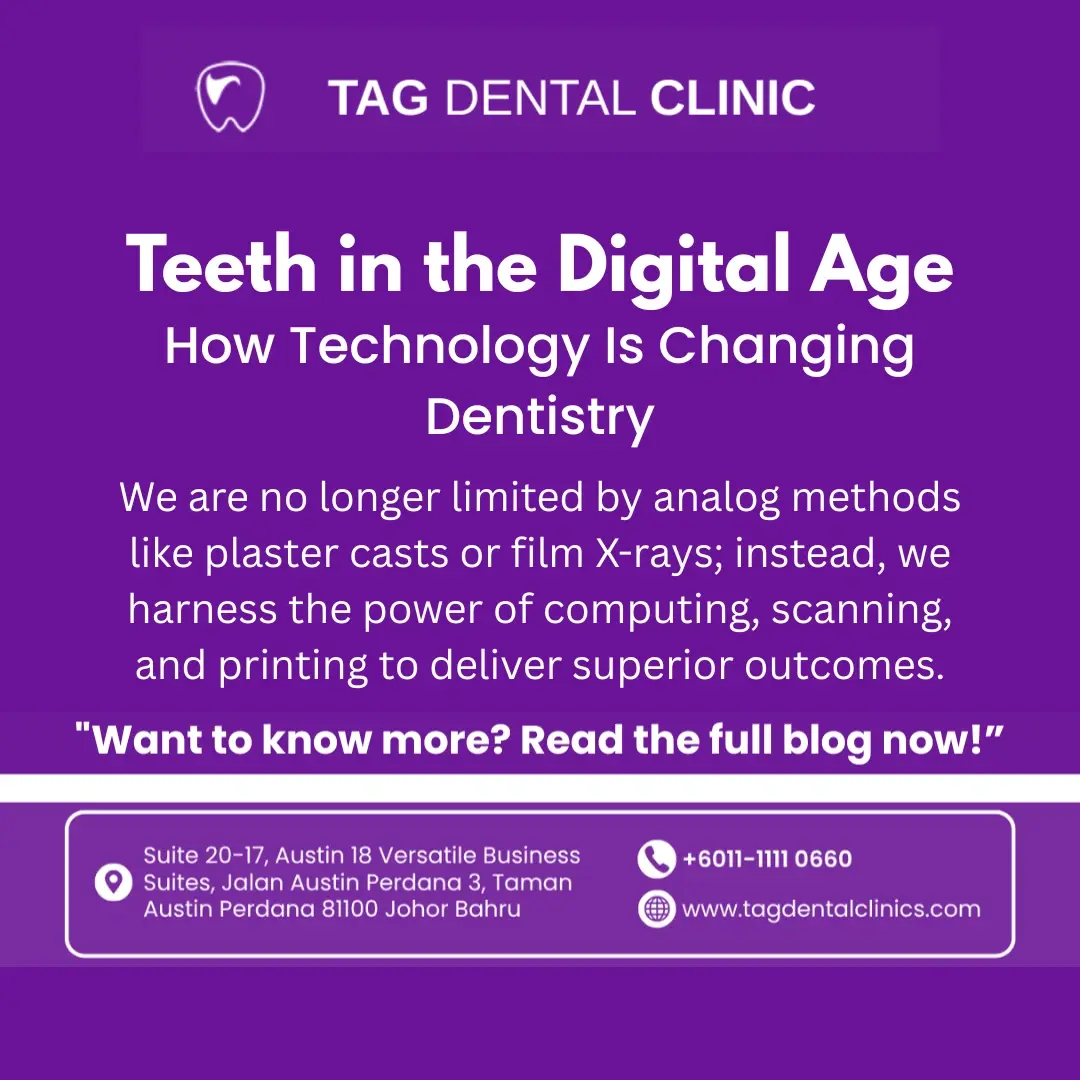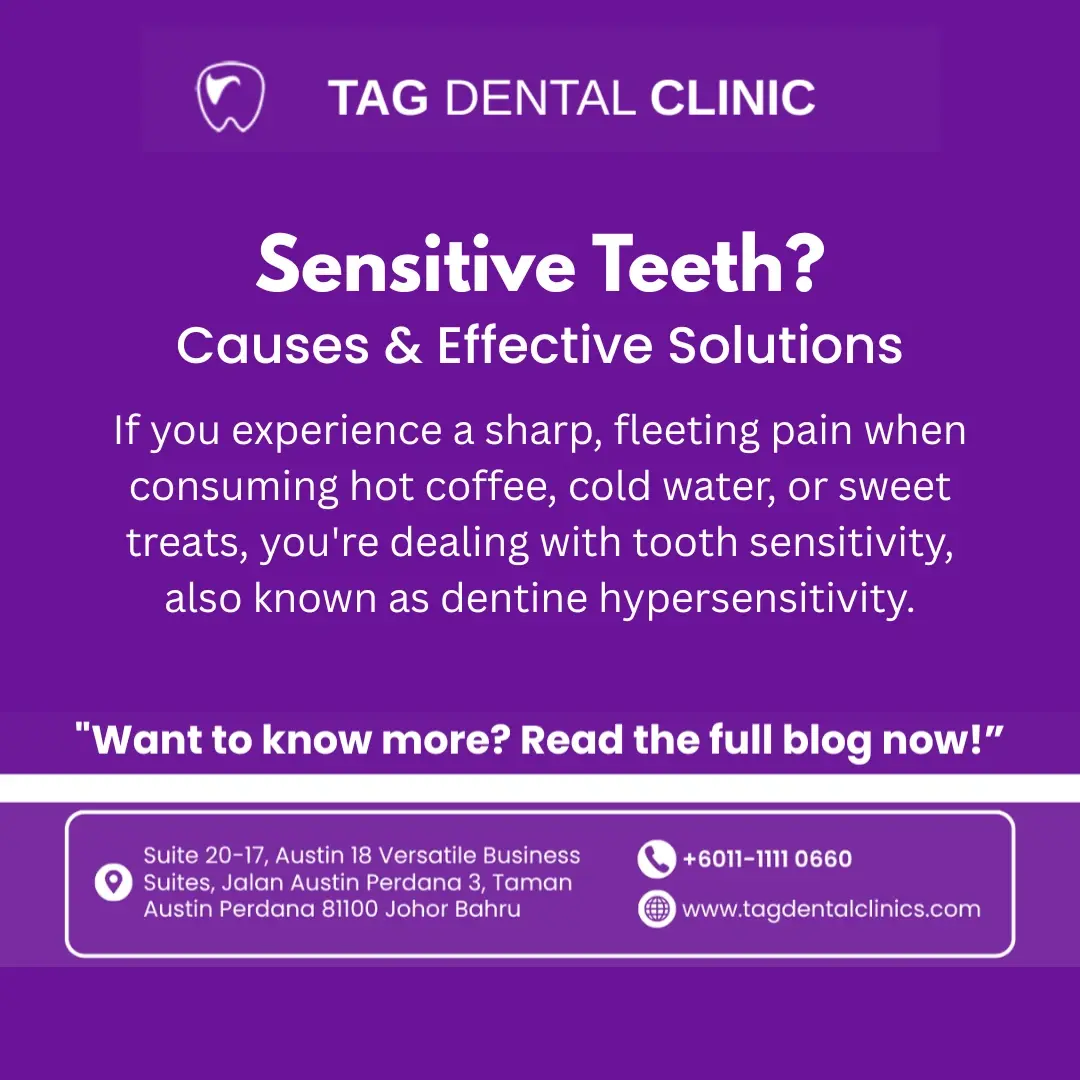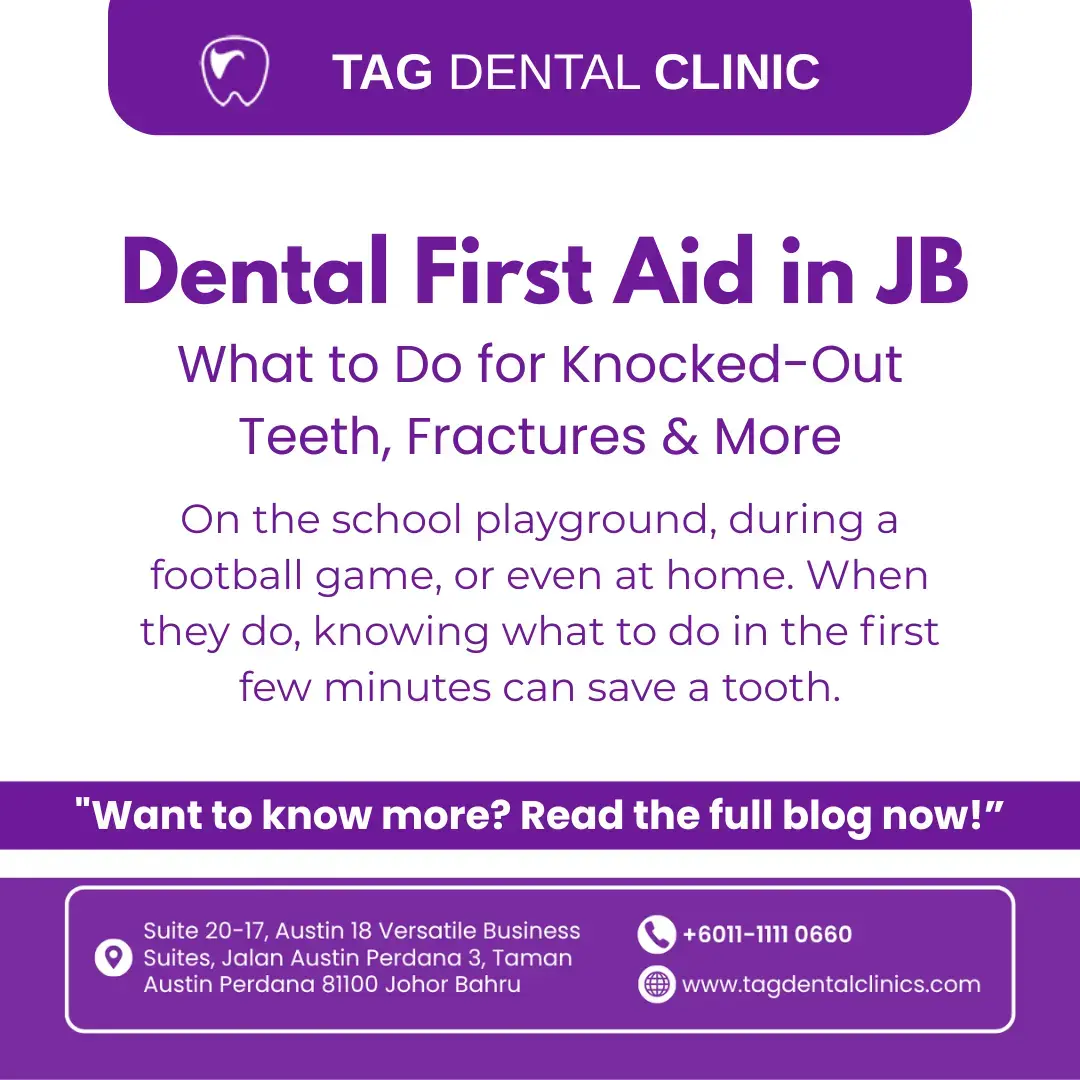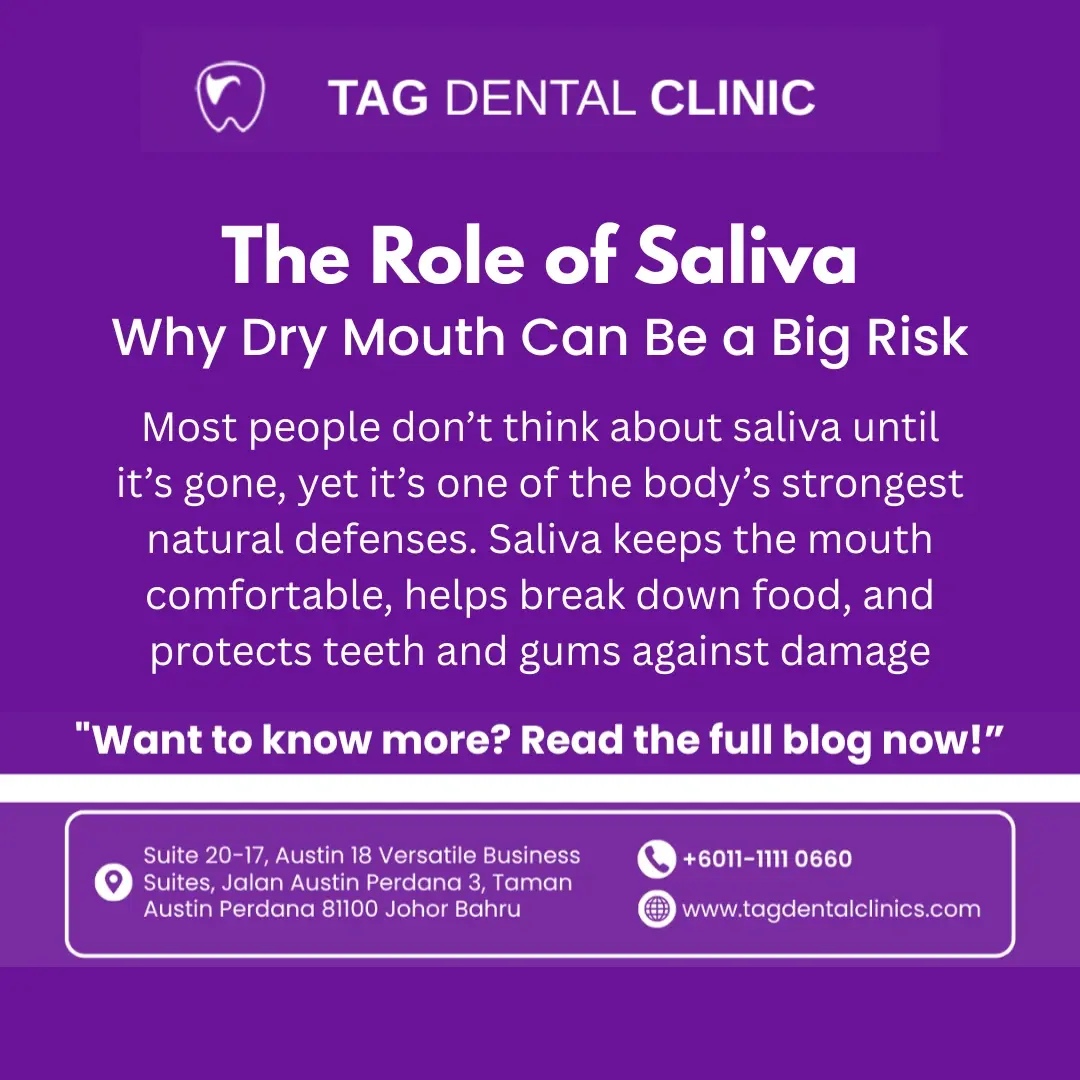Teeth in the Digital Age: How Technology Is Changing Dentistry
Table Of Content

The End of Goop: Introducing Digital Workflows in Modern Dentistry
The experience of visiting the dentist has undergone a revolutionary transformation, moving from messy, time-consuming manual processes to fast, precise, and comfortable digital workflows. We are no longer limited by analog methods like plaster casts or film X-rays; instead, we harness the power of computing, scanning, and printing to deliver superior outcomes.
At TAG Dental in Johor Bahru, we have fully embraced this digital revolution. Our investment in advanced technology is not just about having the newest gadgets—it's about fundamentally improving the patient experience, enhancing accuracy, and drastically reducing treatment time.
Key Technologies Driving Digital Dentistry

The core of the digital age in dentistry relies on three major innovations that work seamlessly together, from diagnosis to final restoration.
1. Intraoral Scanners (The Digital Impression)
Forget the messy, uncomfortable trays filled with gooey impression material. The intraoral scanner uses a small handheld wand to capture thousands of high-definition images of your teeth and gums in seconds, instantly creating a perfect 2D digital model on a screen.
- Benefit: Eliminates patient discomfort, is far more accurate than traditional molds, and the data is instantly available for planning.
2. CAD/CAM Technology (Computer-Aided Design/Manufacturing)
This powerful system allows for the precise design and creation of permanent restorations—such as crowns, inlays, onlays, and some veneers. At TAG Dental, we utilize this technology for all our crown and restorative cases by collaborating closely with well-known, high-precision dental laboratories.
-
The Process: The digital scan (from the intraoral scanner) is fed to the CAD software, where the dentist custom-designs the restoration. The digital file is then electronically sent to our partner lab, which uses their high-precision CAM milling unit to carve the restoration from a solid block of ceramic.
- Benefit: Crowns can be designed and milled with micron-level accuracy, and in many cases, patients can receive a permanent crown in a single visit (same-day dentistry).
3. 2D Printing and Advanced Imaging
Modern 2D printers have replaced many traditional laboratory steps, adding predictability and precision to complex cases.
- Planning and Guides: 2D printing is used to create precise physical models of your teeth, surgical guides for implant placement, and models for complex orthodontic planning. The accuracy of a 2D-printed implant guide ensures the titanium post is placed at the exact depth and angle needed for long-term success.
- Diagnostic Power: Digital X-rays (like CBCT 2D scans) provide detailed, low-radiation views of bone structure, nerve pathways, and joints, allowing for safer, more predictable planning for everything from wisdom tooth extraction to root canal therapy.
How Digital Dentistry Improves Your Experience

| Improvement Area | Digital Advantage | Patient Benefit |
|---|---|---|
| Accuracy & Fit | Digital models have a precision of a few microns (thousandths of a millimeter), far surpassing traditional impressions. | Restorations (crowns, bridges) fit perfectly on the first try, minimizing adjustments and future issues. |
| Comfort | Intraoral scanning replaces messy, gag-inducing impression materials. | The patient experience is more relaxed, faster, and much cleaner. |
| Turnaround Time | Digital workflows streamline the communication between our clinic and the dental lab, allowing for efficient, high-quality fabrication. | You receive a highly customized, permanent crown designed for perfection and longevity, delivered efficiently |
| Predictability | Digital Smile Design (DSD) and 2D planning allow patients to preview their final smile before treatment begins. | Eliminates guesswork, ensuring the patient is fully satisfied with the outcome before any irreversible work is performed. |
| Safety | Guided implant surgery based on 2D scans avoids nerve pathways and vital structures. | Procedures are significantly safer, less invasive, and lead to faster healing times. |
The shift to a tech-forward clinic like TAG Dental translates directly into better results for you.
What Patients Should Expect in a Tech-Forward Clinic

When you visit a digitally advanced clinic like TAG Dental in Johor Bahru, your experience will differ significantly from traditional dentistry.
1. The Consultation is Visual
Your initial consultation will involve looking at screens, not models. You will see a high-resolution, 2D color image of your own mouth. Our dentists can zoom in on a small crack, virtually try on a new crown, or demonstrate how your bite is misaligned—all on screen, making the diagnosis easy to understand.
2. Fewer Appointments
For restorative work (crowns, bridges), we eliminate the need for traditional, messy impressions. Instead, highly accurate digital data is transmitted immediately to the lab, starting the fabrication process sooner. It is important to note that because we partner with external labs for the CAD/CAM milling, we do not offer same-day crowns; however, the overall process is highly efficient.
3. Precision Planning for Implants
If you are receiving dental implants, expect the use of a surgical guide. This is a 2D-printed tool that snaps over your gums, ensuring the implant is placed with near-perfect accuracy, resulting in a less invasive surgery and a quicker recovery time.
4. Digital Records
All your scans, images, and treatment plans are stored digitally. This creates a highly accurate, permanent record that allows our dentists to monitor tiny changes in your oral health over many years with far greater ease than traditional paper charts and film.
Frequently Asked Questions (FAQs) About Digital Dentistry
%20About%20Digital%20Dentistry.webp)
1. Is a digital scanner accurate enough for a crown?
Yes, digital intraoral scanners are consistently proven to be more accurate than traditional physical impressions, resulting in crowns that fit perfectly and last longer.
2. Does "same-day crown" mean I only need one appointment?
While we focus on high-quality, customized outcomes, TAG Dental does not offer same-day crowns because we utilize specialized dental laboratories for the milling process. The process requires a preparation appointment followed by a placement appointment when your permanent crown arrives from the lab.
3. Is 2D dental X-ray (CBCT) radiation safe?
Digital X-rays, including CBCT scans, use significantly less radiation than older film X-rays. They are essential for complex procedures and are used only when necessary for precise planning.
4. How long does the milling of a crown take?
The milling process is done by our partner laboratory and is part of their overall fabrication timeline, which is highly streamlined due to the digital files we provide.
5. Does a digital workflow cost more?
While the initial technology investment is high, the efficiency gained (less chair time, fewer re-dos, no external lab costs) often means the patient receives a superior service with comparable or often better value than traditional methods.
6. Do digital models replace old plaster casts completely?
Yes. The digital files are stored permanently and can be sent to a 2D printer if a physical model is ever needed, completely replacing the need for messy plaster casts.
7. Can digital planning help if I have severe fear of the dentist?
Absolutely. The non-invasive nature of scanning, the elimination of messy materials, and the increased speed of procedures drastically improve comfort and reduce anxiety.
8. Is Digital Smile Design (DSD) only for veneers?
No. DSD is a planning tool used for any treatment that affects the appearance of your smile, including orthodontics, crowns, implants, and gum contouring.
9. What is the biggest advantage of digital technology in implant surgery?
The biggest advantage is the surgical guide, which ensures the implant is placed in the exact optimal position, reducing the risk of complications and leading to a less invasive surgery.
10. What is the most important question to ask a tech-forward clinic?
Ask your dentist about their ongoing training and how long they have been utilizing the specific technology (like CAD/CAM or guided surgery). Expertise is what brings technology to life.

The digital age has delivered a promise of dentistry that is safer, faster, and far more comfortable. At TAG Dental in Johor Bahru, we leverage these cutting-edge tools and strategic lab partnerships to provide you with restorations that are microscopically accurate and smiles that are digitally designed for perfection. Experience the future of dentistry firsthand—schedule your appointment with us today.





